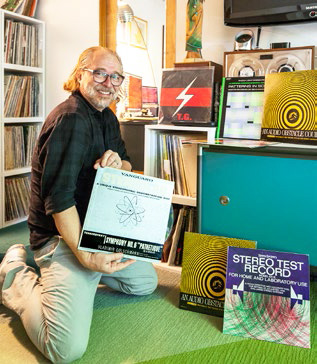CollectorMANIA - Page 2
 |
|
|
 |
|
|
 |
|
|
|
|
"We got it home. I couldn't push it up the stairs, so I left it downstairs by the front door. My wife came in late that night from work. The first thing she sees is the jukebox. I heard a yell. A scream! 'This jukebox is hideous, we can't keep this thing.'"
"Then two weeks later I hear her on the phone, 'Oh, you've got to come over and see this jukebox!'"
Talk to collectors and it becomes clear—it's not about the objects. Oh, sure, collectors love what they collect. Lisa Berghout is wild about a 1967 cityscape in patchwork thread and fabric hanging in the bedroom. "I love it," she says. "A woman won it at an anti-Prop 13 rally."
Throughout their home are abstract expressionist canvasses from thrift stores and the like that prove that art by unknowns can be great.
The McMullans' home may be crammed with mid-century collectables and more of all stripes—from a rack of tiki bar matches and stuffed big-game heads to a 1965 Avion Holiday trailer parked in the backyard—but when Cindy wants to bask in pleasure she pulls out her vintage jewelry.
"Everybody likes something," Jeff Morelli says. "For me, it's sofas. Funky sofas. The only trouble is, you can only put one sofa in a room. So where do you put them?"
One of his favorites, which was being hawked over eBay from Florida, is goldish-green with broad, lazy arm rests and tall, diamond stitchery, circa 1961. "I thought, if that isn't 'Rat Pack,' with the diamonds," Jeff says.
Like many collectors, Morelli buys based on looks, intuition, and feel—not by the name of the designer.
"A lot of my stuff is no name," he says, "and I think it's cooler-looking than some of the stuff that is named. I like that offbeat look. A lot of people don't. They go for Herman Miller, Eames, the other well-known names. A lot of that stuff is pretty tame, to me."
Walnut Creek Eichler owner Boris Letuchy, whose collections include no-name, handmade pottery from the 1950s and '60s that he chooses for their looks, enjoys just as much their backstory. He believes many were made by students apprenticing with such well-known artists as Marguerite Wildenhain.
"They had unusual shapes and forms," he says, handling first one, then another of the pieces, which are on shelves in his living room. Many come from estate sales. "People were having fun and experimenting. These were not made as a business, for resale. It was made by people who were experimenting and learning. That's what I find most fascinating about it."




